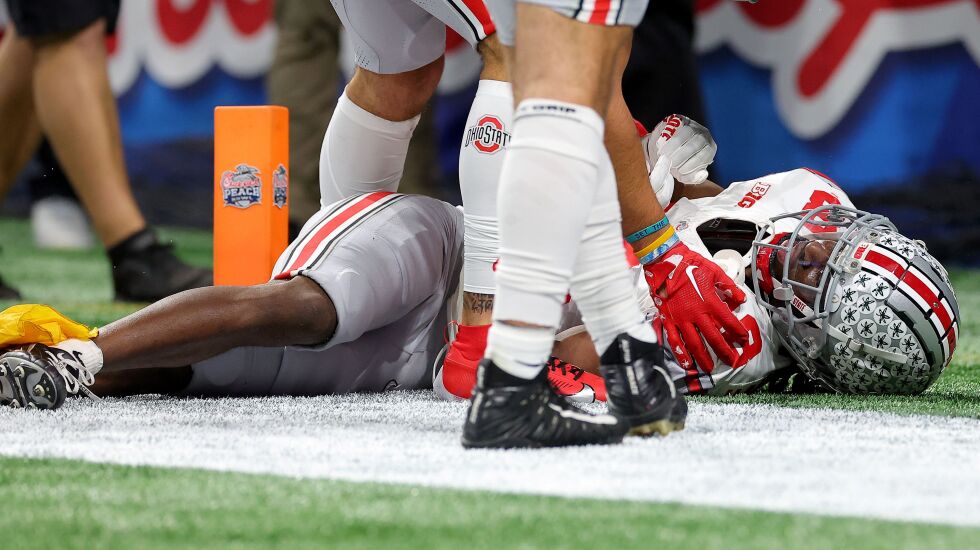
NFL players are modern-day ‘‘gladiators.’’ That’s a word anyone following the story of Bills safety Damar Hamlin — who went into cardiac arrest after a tackle on ‘‘Monday Night Football’’ and is in critical condition — keeps hearing and reading.
Players are bigger, stronger and faster than ever. Collisions can be shockingly violent. Changes to rules and equipment mitigate some of the danger, but the risks to all who play in the NFL are enormous. The threat of the next grievous injury always hangs in the air.
Cable news went wall-to-wall with coverage in the hours after the game, buzzing with talk of this danger. The NFL schedule has gotten longer. The playoffs are around the corner, and somehow the Bills — and players on other teams — will have to blink back the hurt and horror from Monday night and soldier on. It was the last Monday game of the NFL season.
It’s all so cold.
But it’s also not the last Monday of football season. Next Monday at SoFi Stadium in Inglewood, California, Georgia and TCU — each playing for the 15th time this season — will gear up and beat the hell out of each other in a fight for the national championship. In other words, they’ll play football.
All the gladiator talk, all the danger, all the reasons players play and how they weigh — or ignore — the risks, it applies to the Bulldogs and Horned Frogs, too. It applies to the couple of thousand athletes who play for NFL teams every year and the 75,000 or so who play college football. And that’s saying nothing of all the kids — around a million — playing high school ball.
It just seems worth remembering them all at a time like this.
In the Peach Bowl on Saturday in Atlanta, there was a hit heard ’round the college football world. Georgia safety Javon Bullard unloaded on Ohio State receiver Marvin Harrison Jr. in the back of the end zone, saving a touchdown and — more important, one would hope — knocking Harrison out of the game. Injuring him, in other words. Part of the game, no doubt, but these are still human beings.
A reporter happened to ask Bullard on Tuesday about Hamlin’s on-field crisis.
‘‘I’ve never seen nothing like that as far as, like, a dude’s heart stopping,’’ Bullard said. ‘‘I didn’t even know that was possible in football, to be honest with you.’’
No doubt, it was beyond most anyone’s imagination, even if it wasn’t unprecedented. In 1971, the Lions’ Chuck Hughes had a heart attack during a game against the Bears and was taken from the field in an ambulance and pronounced dead at a hospital in Detroit.
But Bullard, like any player, fan or even casual observer, surely knows that football is, on some level, a life-or-death proposition for everyone who makes a team. That’s in part because of the insidious punishments doled out over many years resulting from brain injuries, but there are football-related ways in which a player’s life can be at risk in an instant.
An article published by the National Library of Medicine cited 33 football-related deaths of NCAA players from 2000 to 2017, a majority of them categorized as ‘‘non-traumatic’’ — heat stroke, sudden cardiac death, exertion collapse associated with sickle-cell trait, asthma — under the umbrella of offseason conditioning.
According to one study by the Centers for Disease Control, 28 traumatic brain and spinal-cord injury deaths were identified in high school and college football from 2005 to 2014. There were four in college football from 2010 to 2014, two during practices and two during games. In 2017, defensive back Robert Grays of Division II Midwestern State died three days after suffering a neck injury on a tackle during a game.
They weren’t ‘‘gladiators’’ in the primal sense, certainly not like NFL players are — titillating millions, their livelihoods constantly on the line — but they weren’t all that far off. And Georgia-TCU is a lot closer to an NFL stage than it is to the lower rungs of college football.
There are 15 players on Georgia’s injury list heading into the title game. Most of them are knees and ankles, shoulders and pecs. But there’s also linebacker CJ Washington, a freshman linebacker who enrolled early last spring and barely got on the field before he injured his neck. Washington has been out since. Information from the school has been scarce, but he is said to be slowly working his way back.
I don’t care if he plays again; I just hope he’s all right.
That goes for the rest of them, too, and all the gladiators everywhere.







